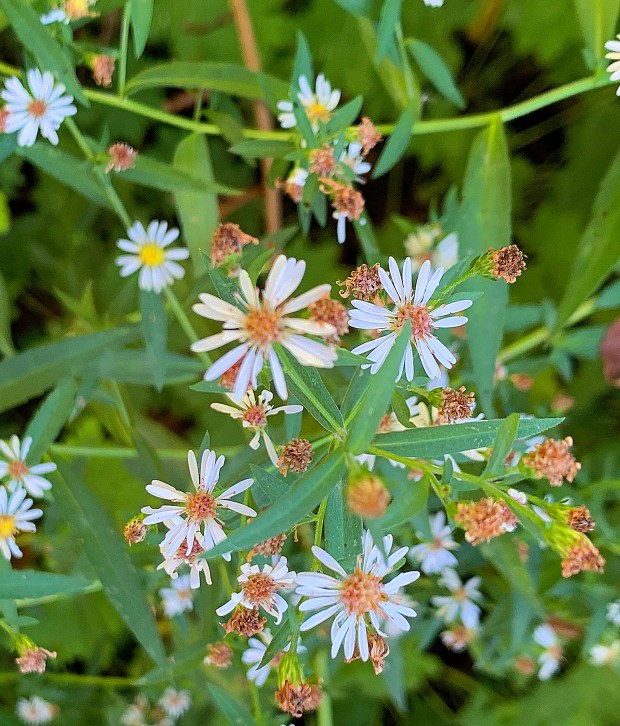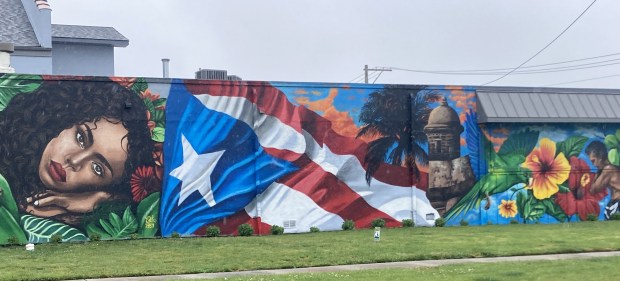I began a quest to learn to identify asters, all those multi-petal, tiny daisy-like flowers in hues of pink, purple and white blooming in autumn and attracting myriad species of bees and other insects.
Asters are in a large family of plants that have ray flowers or petals emanating from the center. They look like petals and surround a round disk. Many tiny, thin flowers comprise the center. I looked at the disk through a magnifying glass and was amazed at the complexity of these flowers.
The easiest aster to identify is the standout New England aster, with its bold purple petals called ray flowers, emanating from a central yellow round disk.
The color of the ray flowers and of the central disk flowers sometimes offers a clue as to the species. But as autumn changes, so do the colors of the ray flowers and disk flowers, making identifying asters by color alone challenging.
To identify asters, botanists use other details, such as the number of ray flowers, hairiness or lack of hairiness on the plant, the shape and size of the leaves, and more.
Walking through Wright Woods in Vernon Hills, I saw several different species of asters with bluish and white ray flowers. The only one I could easily identify was, of course, the New England aster. But I wanted to learn at least a few more, so I started with what’s in my yard.
I don’t recall planting these, but in my front yard are low-to-the-ground, sprawling asters with an average of 9 to 16 ray flowers. The disk flowers are yellow, and later turn purple. The central disk is barely a centimeter in diameter, making them the smallest asters I’ve encountered on my forays. They grow right next to the New England asters, which have 45 or more ray flowers per plant, and stand much taller than the calico asters.
Using a magnifying glass to count the number of ray flowers, I saw many bees, tiny ones, large bumblebees and bright green medium-sized bees. My mind got distracted when I tried to identify all the bees, and though nature identification can get frustrating, it’s also so amazing to know how many different species are out there and how they are all working together right before your eyes.
Asters are late-bloomers, waiting until the spring and summer wildflowers are gone, so they can attract the pollinators that are still active in autumn. Pollinators help asters create seeds that promise a new crop next year.
By now, the milkweeds from which monarchs have gathered nectar all summer have faded and are sending out seeds instead of nectar. But the bright New England asters beckon to monarchs, offering them sustenance on their migratory journey.
Insects that overwinter in northern Illinois beneath the ground or in some rotting log or leaf litter, rely on asters to get the nourishment they need this time of year to fatten before they go dormant. An example of one of these insects is the caterpillar of the pearl crescent butterfly. This species lays its eggs later in the season and the caterpillars are just emerging now, finding juicy leaves of asters still tender and nutritious. These caterpillars will spend winter in northern Illinois as well.
I’ve read that every garden deserves at least three different types of asters. I have three, the calico, New England and white panicle, which is long, hairless with 16 to 50 white ray flowers.
I only remember planting the New England asters; the calico and panicle arrived on their own. They’re growing in sunny spots, which asters need, and they have done well even through the recent drought. Once established, many aster species can do well on their own without any extra water.
They are truly the stars of the garden in autumn, and in fact, asters get their name from a Greek word meaning “star.” Here on Earth close to the ground, we see copious colorful stars in autumn, and then at night we can look to the sky to see many more stars from afar.
Sheryl DeVore has worked as a full-time and freelance reporter, editor and photographer for the Chicago Tribune and its subsidiaries. She’s the author of several books on nature and the environment. Send story ideas and thoughts to sheryldevorewriter@gmail.com.





